Configuring Time-of-Day Routing
To access the time-of-day routing configuration components, choose Route Plan > Class of Control > Time Period or Route Plan > Class of Control > Time Schedule. Figure 13-6 illustrates these options.
Figure 13-6. Time-of-Day Routing Configuration
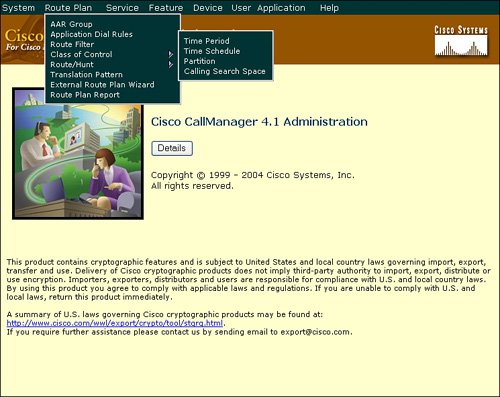
To configure time-of-day routing, follow these steps:
|
Step 1. |
Create the individual time periods. |
|
Step 2. |
Create the time schedule and assign the time periods to it. |
|
Step 3. |
Assign the time schedule to a partition. |
Configuring Time Periods
To add and configure a time period, follow this procedure:
|
Step 1. |
In the menu bar, choose Route Plan > Class of Control > Time Period. |
|
Step 2. |
Click Add a New Time Period. |
|
Step 3. |
Enter the time period name, start time, end time, and repetition interval. |
|
Step 4. |
To add the new time period, click Insert. |
|
Step 5. |
To add more time periods, click Add a New Time Period and repeat this procedure. |
Figure 13-7 shows an example of a time period named OfficeHoursTP, a start time of 08:00, an end time of 17:00, and a weekly repetition interval of every Monday through Friday.
Figure 13-7. Time Period Configuration Window
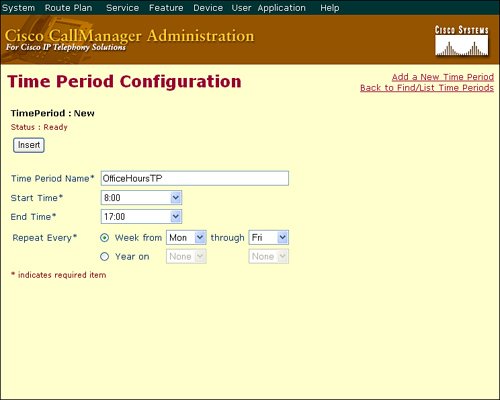
Table 13-1 provides a list of options available to you when implementing time periods.
|
Parameter |
Description |
|---|---|
|
Time Period Name |
Enter a name in the Time Period Name field. The name can include up to 50 alphanumeric characters and can contain any combination of spaces, periods (.), hyphens (-), and underscore characters (_). Ensure that each time period name is unique to the plan. Use concise and descriptive names for your time periods. The hours_or_days format usually provides a sufficient level of detail and is short enough to enable you to quickly and easily identify a time period. For example, office_M_to_F identifies a time period for the business hours of an office from Monday to Friday. |
|
Start Time |
Time when this time period starts. The available start times are 15-minute intervals throughout a 24-hour day. The default value is No Office Hours. No Office Hours means that the selected partition will not be active for the defined day of year or days of week. To start a time period at midnight, choose the 0:00 value. |
|
End Time |
Time when this time period ends. The available end times are 15-minute intervals throughout a 24-hour day. The default value is No Office Hours. To end a time period at midnight, choose the 24:00 value. |
|
Repeat Every |
Click one of the radio buttons to set a schedule:
Examples: Choose a From value of Mon(day) and a Through value of Fri(day) to define a time period that applies from Monday to Friday. Choose a From value of Sat(urday) and a Through value of Sat(urday) to define a time period that applies only on Saturdays.
Example: Choose the month Jan(uary) and the day 1 to define a time period that applies yearly on New Year's Day. |
Figure 13-8 shows how to create a time period using the No Office Hours time interval and a repetition interval with a specific day of the year defined. When the No Office Hours time interval is selected, the associated partition is not active for the defined days of the week or day of the yearin this example, December 25.
Figure 13-8. Creating a Christmas Time Period
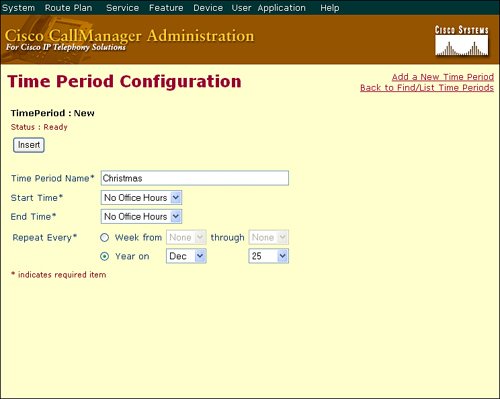
Use the No Office Hours time interval and the Year On repetition interval for days, such as Christmas, New Year's Day, and national holidays, when for example, the company is closed, certain departments are closed, or certain employees are on holiday.
Configuring Time Schedules
After the time periods are created, you can create the time schedule:
|
Step 1. |
In the menu bar, choose Route Plan > Class of Control > Time Schedule. |
|
Step 2. |
Click Add a New Time Schedule. |
|
Step 3. |
Name the time schedule in the Time Schedule Name field. |
|
Step 4. |
Choose the desired time periods from the Available Time Periods pane, shown in Figure 13-9, and use the down arrow to move them to the Selected Time Periods pane. Move any time periods you do not want in the Selected Time Periods pane to the Available Time Periods pane. Figure 13-9. Creating a Time Schedule 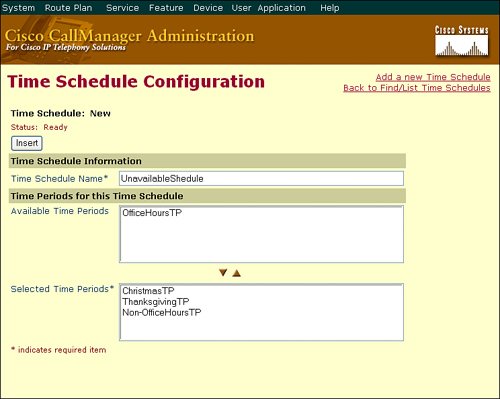
|
|
Step 5. |
To add the new time schedule, click Insert (or Update if the time schedule already exists and you are changing it). |
|
Step 6. |
To add more time schedules, click Add a New Time Schedule and repeat this procedure. |
Applying Time Schedules
Associating the time schedule (collection of time periods) to a partition is the final step in configuring time-of-day routing. A time schedule is not activated until it is assigned to a partition. In Cisco IOS software, this process is similar to creating an access control list (ACL) that does not become activated until it is assigned to an interface.
Tip
Cisco CallManager allows you to create duplicate route patterns as long as they are assigned to different partitions. This grants the flexibility to create a route pattern and assign it to a partition for which you have assigned specific time-of-day restrictions for some users. You can then create an identical route pattern and assign it to a partition without time-of-day calling restrictions for other users. You can control user access privileges through the partition you assign to their calling search space.
You can create a new partition from the Partition Configuration window and assign the time schedule to it or assign the time schedule to an existing partition, as shown in Figure 13-10. The process is the same:
|
Step 1. |
From the Time Schedule drop-down menu, choose a time schedule to associate with this partition. |
|
Step 2. |
Choose either the time zone of the originating device or any specific time zone for a time schedule. The system checks the chosen time zone against the time schedule when the call is placed to directory numbers in this partition. |
Figure 13-10. Assigning a Time Schedule to a Partition
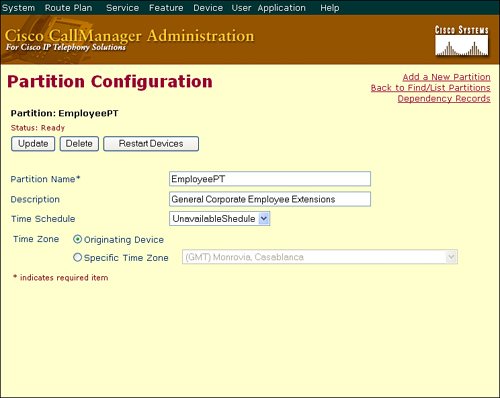
Table 13-2 provides a list of available options when applying a time schedule to a partition.
|
Parameter |
Description |
|---|---|
|
Time Schedule |
From the drop-down menu, choose a time schedule to associate with this partition. The associated time schedule specifies when the partition is available to receive incoming calls. The default value specifies None, which means that time-of-day routing is not in effect and the partition remains active at all times. In combination with the time zone value in the following field, associating a partition with a time schedule configures the partition for time-of-day routing. The system checks incoming calls to this partition against the specified time schedule. |
|
Time Zone |
Choose one of the following options to associate a partition with a time zone:
These options all specify the time zone. When there is an incoming call, the current time on the Cisco CallManager is converted into the specific time zone that you set. This specific time is validated against the value in the Time Schedule field. |
Part I: Cisco CallManager Fundamentals
Introduction to Cisco Unified Communications and Cisco Unified CallManager
Cisco Unified CallManager Clustering and Deployment Options
- Cisco Unified CallManager Clustering and Deployment Options
- The Two Sides of the Cisco Unified CallManager Cluster
- Cluster Redundancy Designs
- Call-Processing Deployment Models
- Summary
- Review Questions
Cisco Unified CallManager Installation and Upgrades
- Cisco Unified CallManager Installation and Upgrades
- Cisco Unified CallManager 4.x Clean Installation Process
- Upgrading Prior Cisco Unified CallManager Versions
- Summary
- Review Questions
Part II: IPT Devices and Users
Cisco IP Phones and Other User Devices
Configuring Cisco Unified CallManager to Support IP Phones
- Configuring Cisco Unified CallManager to Support IP Phones
- Configuring Intracluster IP Phone Communication
- IP Phone Configuration
- Case Study: Device Pool Design
- Summary
- Review Questions
Cisco IP Telephony Users
- Cisco IP Telephony Users
- Cisco CallManager User Database
- Cisco CallManager User Configuration
- User Logon and Device Configuration
- Summary
- Review Questions
Cisco Bulk Administration Tool
- Cisco Bulk Administration Tool
- The Cisco Bulk Administration Tool
- Using the Tool for Auto-Registered Phone Support
- Summary
- Review Questions
Part III: IPT Network Integration and Route Plan
Cisco Catalyst Switches
- Cisco Catalyst Switches
- Catalyst Switch Role in IP Telephony
- Powering the Cisco IP Phone
- Data and Voice VLANs
- Configuring Class of Service
- Summary
- Review Questions
Configuring Cisco Gateways and Trunks
- Configuring Cisco Gateways and Trunks
- Cisco Gateway Concepts
- Configuring Access Gateways
- Cisco Trunk Concepts
- Configuring Intercluster Trunks
- SIP and Cisco CallManager
- Summary
- Review Questions
Cisco Unified CallManager Route Plan Basics
- Cisco Unified CallManager Route Plan Basics
- External Call Routing
- Route Plan Configuration Process
- Summary
- Review Questions
Cisco Unified CallManager Advanced Route Plans
- Cisco Unified CallManager Advanced Route Plans
- Route Filters
- Discard Digit Instructions
- Transformation Masks
- Translation Patterns
- Route Plan Report
- Summary
- Review Questions
Configuring Hunt Groups and Call Coverage
- Configuring Hunt Groups and Call Coverage
- Call Distribution Components
- Configuring Line Groups, Hunt Lists, and Hunt Pilots
- Summary
- Review Questions
Implementing Telephony Call Restrictions and Control
- Implementing Telephony Call Restrictions and Control
- Class of Service Overview
- Partitions and Calling Search Spaces Overview
- Time-of-Day Routing Overview
- Configuring Time-of-Day Routing
- Time-of-Day Routing Usage Scenario
- Summary
- Review Questions
Implementing Multiple-Site Deployments
- Implementing Multiple-Site Deployments
- Call Admission Control
- Survivable Remote Site Telephony
- Summary
- Review Questions
Part IV: VoIP Features
Media Resources
- Media Resources
- Introduction to Media Resources
- Conference Bridge Resources
- Media Termination Point Resources
- Annunciator Resources
- Transcoder Resources
- Music on Hold Resources
- Media Resource Management
- Summary
- Review Questions
Configuring User Features, Part 1
- Configuring User Features, Part 1
- Basic IP Phone Features
- Softkey Templates
- Enhanced IP Phone Features
- Barge and Privacy
- IP Phone Services
- Summary
- Review Questions
Configuring User Features, Part 2
- Configuring User Features, Part 2
- Cisco CallManager Extension Mobility
- Client Matter Codes and Forced Authentication Codes
- Call Display Restrictions
- Malicious Call Identification
- Multilevel Precedence and Preemption
- Summary
- Review Questions
Configuring Cisco Unified CallManager Attendant Console
- Configuring Cisco Unified CallManager Attendant Console
- Introduction to Cisco CallManager Attendant Console
- Call Routing and Call Queuing
- Server and Administration Configuration
- Cisco Attendant Console Features
- Summary
- Review Questions
Configuring Cisco IP Manager Assistant
- Configuring Cisco IP Manager Assistant
- Cisco IP Manager Assistant Overview
- Cisco IP Manager Assistant Architecture
- Configuring Cisco IPMA for Shared-Line Support
- Summary
- Review Questions
Part V: IPT Security
Securing the Windows Operating System
- Securing the Windows Operating System
- Threats Targeting the Operating System
- Security and Hot Fix Policy
- Operating System Hardening
- Antivirus Protection
- Cisco Security Agent
- Administrator Password Policy
- Common Windows Exploits
- Security Taboos
- Summary
- Review Questions
Securing Cisco Unified CallManager Administration
- Securing Cisco Unified CallManager Administration
- Threats Targeting Remote Administration
- Securing CallManager Communications Using HTTPS
- Multilevel Administration
- Summary
- Review Questions
Preventing Toll Fraud
- Preventing Toll Fraud
- Toll Fraud Exploits
- Preventing Call Forward and Voice-Mail Toll Fraud Using Calling Search Spaces
- Blocking Commonly Exploited Area Codes
- Using Time-of-Day Routing
- Using FAC and CMC
- Restricting External Transfers
- Dropping Conference Calls
- Summary
- Review Questions
Hardening the IP Phone
Understanding Cryptographic Fundamentals
- Understanding Cryptographic Fundamentals
- What Is Cryptography?
- Symmetric Encryption
- Asymmetric Encryption
- Hash Functions
- Digital Signatures
- Summary
- Review Questions
Understanding the Public Key Infrastructure
- Understanding the Public Key Infrastructure
- The Need for a PKI
- PKI as a Trusted Third-Party Protocol
- PKI Entities
- PKI Enrollment
- PKI Revocation and Key Storage
- PKI Example
- Summary
- Review Questions
Understanding Cisco IP Telephony Authentication and Encryption Fundamentals
- Understanding Cisco IP Telephony Authentication and Encryption Fundamentals
- Threats Targeting the IP Telephony System
- How CallManager Protects Against Threats
- PKI Topologies in Cisco IP Telephony
- PKI Enrollment in Cisco IP Telephony
- Keys and Certificate Storage in Cisco IP Telephony
- Authentication and Integrity
- Encryption
- Summary
- Review Questions
Configuring Cisco IP Telephony Authentication and Encryption
- Configuring Cisco IP Telephony Authentication and Encryption
- Authentication and Encryption Configuration Overview
- Enabling Services Required for Security
- Using the CTL Client
- Working with Locally Significant Certificates
- Configuring the Device Security Mode
- Negotiating Device Security Mode
- Generating a CAPF Report
- Summary
- Review Questions
Part VI: IP Video
Introducing IP Video Telephony
- Introducing IP Video Telephony
- IP Video Telephony Solution Components
- Video Call Concepts
- Video Protocols Supported in Cisco CallManager
- Bandwidth Management
- Call Admission Control Within a Cluster
- Call Admission Control Between Clusters
- Summary
- Review Questions
Configuring Cisco VT Advantage
- Configuring Cisco VT Advantage
- Cisco VT Advantage Overview
- How Calls Work with Cisco VT Advantage
- Configuring Cisco CallManager for Video
- Configuring Cisco IP Phones for Cisco VT Advantage
- Installing Cisco VT Advantage on a Client
- Summary
- Review Questions
Part VII: IPT Management
Introducing Database Tools and Cisco Unified CallManager Serviceability
- Introducing Database Tools and Cisco Unified CallManager Serviceability
- Database Management Tools
- Cisco CallManager Serviceability Overview
- Tools Overview
- Summary
- Review Questions
Monitoring Performance
- Monitoring Performance
- Performance Counters
- Microsoft Event Viewer
- Microsoft Performance Monitor
- Real-Time Monitoring Tool Overview
- Summary
- Review Questions
Configuring Alarms and Traces
- Configuring Alarms and Traces
- Alarm Overview
- Alarm Configuration
- Trace Configuration
- Trace Analysis
- Trace Collection
- Bulk Trace Analysis
- Additional Trace Tools
- Summary
- Review Questions
Configuring CAR
- Configuring CAR
- CAR Overview
- CAR Configuration
- Report Scheduling
- System Database Configuration
- User Report Configuration
- Summary
- Review Questions
Using Additional Management and Monitoring Tools
- Using Additional Management and Monitoring Tools
- Remote Management Tools
- Dependency Records
- Password Changer Tool
- Cisco Dialed Number Analyzer
- Quality Report Tool
- Summary
- Review Questions
Part VIII: Appendix
Appendix A. Answers to Review Questions
Index
EAN: 2147483647
Pages: 329
